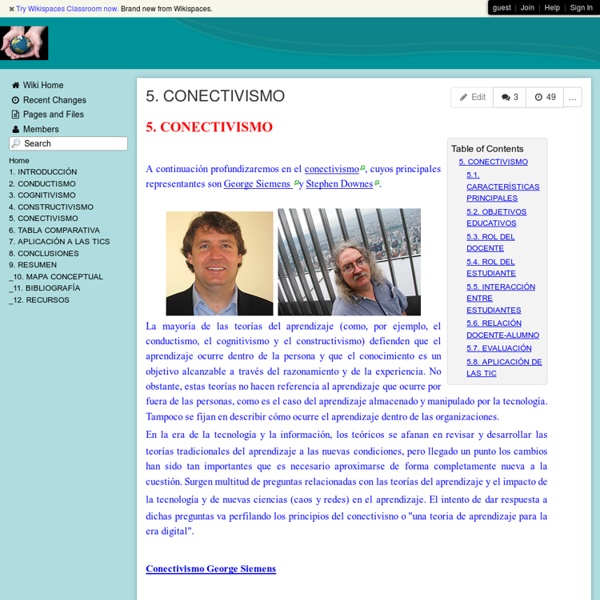



elearnspace. Connectivism: A Learning Theory for the Digital Age Connectivism: A Learning Theory for the Digital Age December 12, 2004 George Siemens Update (April 5, 2005): I've added a website to explore this concept at www.connectivism.ca Introduction Behaviorism, cognitivism, and constructivism are the three broad learning theories most often utilized in the creation of instructional environments. Learners as little as forty years ago would complete the required schooling and enter a career that would often last a lifetime. “One of the most persuasive factors is the shrinking half-life of knowledge. Some significant trends in learning: Many learners will move into a variety of different, possibly unrelated fields over the course of their lifetime. Background Driscoll (2000) defines learning as “a persisting change in human performance or performance potential…[which] must come about as a result of the learner’s experience and interaction with the world” (p.11). Driscoll (2000, p14-17) explores some of the complexities of defining learning. Conclusion:
PLANIFICACIO ACTV1 Yes, Digital Literacy. But Which One? | Hapgood One of the problems I’ve had for a while with traditional digital literacy programs is that they tend to see digital literacy as a separable skill from domain knowledge. In the metaphor of most educators, there’s a set of digital or information literacy skills, which is sort of like the factory process. And there’s data, which is like raw material. You put the data through the critical literacy process and out comes useful information on the other side. You set up the infolit processes over a few days of instruction, and then you start running the raw material through the factory, for everything from newspaper articles on the deficit to studies on sickle cell anemia. Useful information, correctly weighted, comes out the other end. This traditional information/web literacy asks students to go to a random page and ask questions like “Who runs this page? You might even get an acronym, like RADCAB, which allows you to look at any resource and ascertain its usefulness to a task. Source One
INTEGRACIO ACTV1 Los mejores lectores de noticias RSS para Linux Nada más comenzar el año os recordamos cómo seguir a MuyLinux, o mejor dicho, los diferentes medios que tenéis para hacerlo. Y de todos os recomendamos RSS/Atom como el más potente por varias razones. Medios para seguir la actualidad hay muchos, pero pocos ofrecen las ventajas de la llamada redifusión web. Sobre este tema, sobre por qué los RSS -nos quedamos con el formato líder como sinónimo de sindicación web- siguen siendo una solución no solo recomendada, sino óptima para estar al tanto de las informaciones que nos interesan, me extendí hace un año en las páginas de MuyComputer. Y como lo que se menciona en ese artículo mantiene su vigencia, no vale la pena repetirse. Hoy vamos directos al grano, a las aplicaciones disponibles para disfrutar de la redifusión web en el escritorio Linux y más allá. Es decir, si ya usas algo de lo mencionado, incorporar RSS a tu día a día es muy fácil. Liferea Liferea es una aplicación GTK, por lo que se verá y comportará mejor en escritorios GTK. Feedly
DISSENY ACTV2 Resumen del informe Horizon 2012: edición iberoamericana Tiempo estimado de lectura: 3 minutos Fuente: uoc.edu En este mes de octubre se ha publicado el informe Horizon 2012 en su versión iberoamericana. Horizonte de implantación: 1 año o menos Aplicaciones móviles La amplia difusión de terminales móviles inteligentes (smartphones) entre la población, unido a un modelo predominante de distribución de aplicaciones a bajo coste, ha propiciado que exista un espacio abonado para la creatividad casi sin límites. Por este motivo, esta tecnología es de adopción inmediata en el ámbito educativo. Computación en la nube La capacidad de acceder a servicios y archivos desde cualquier lugar y en cualquier dispositivo ofrece a los usuarios la posibilidad de trascender las limitaciones propias de décadas pasadas. Contenido abierto Esta tendencia es consecuencia de un enfoque pedagógico en el que se pone más énfasis en el proceso de aprendizaje y menos en la información transmitida. Horizonte temporal: 2 a 3 años Entornos personales de aprendizaje Me gusta: